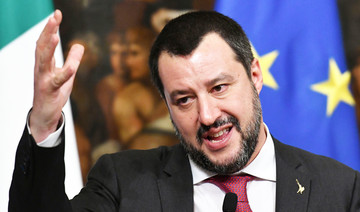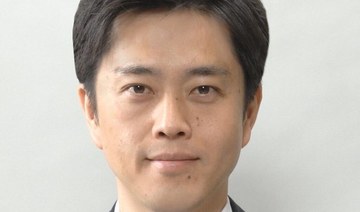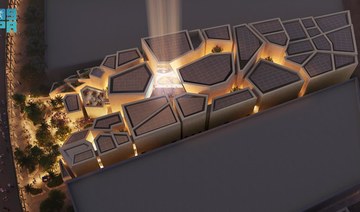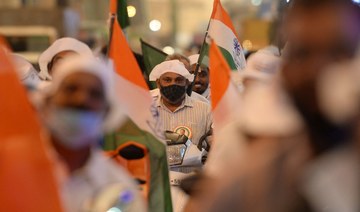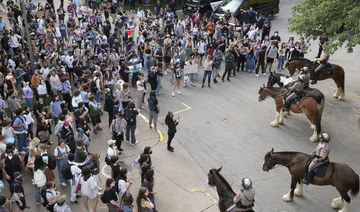ROME: Italian Prime Minister Giuseppe Conte said Tuesday he would resign, lashing out at far-right Interior Minister Matteo Salvini for pursuing his own interests by pulling the plug on the government coalition.
The move leaves the eurozone’s third largest economy in a political vacuum until President Sergio Mattarella decides whether to form a new coalition or call an election after talks with parties in the coming days.
“I’m ending this government experience here... I will go to the president of the republic to inform him of my resignation,” Conte said after an almost hour-long speech to the Senate.
“It is irresponsible to initiate a government crisis,” Conte said after Salvini began his efforts to bring down the government in the hope of snap elections he believes will make him premier.
Conte was speaking following a week of fallout from Salvini’s decision to back out of the alliance between his League party and the anti-establishment Five Star Movement on August 8, plunging Italy into political turmoil.
After Conte announced his intention to resign, Senate speaker Elisabette Casellati told Salvini to leave the government bench and join his party’s senators, where Salvini said: “Thank you, finally, I would do it all again.”
“The Italians vote with their heads and hearts,” Salvini said, invoking the Virgin Mary to “protect the Italian people” and repeating his call for snap elections while also making a final appeal to M5S.
Caught on the back foot, Salvini last week made the surprise offer to back a key M5S proposal to cut the number of lawmakers from 950 to 605, but only if new elections were then swiftly held.
“Making citizens vote is the essence of democracy, asking them to vote every year is irresponsible,” Conte said as League senators booed and hissed.
“I heard you calling for ‘full powers’ and invoke (demonstrations in) the piazzas to support you, which worries me,” Conte said.
Italian dictator Benito Mussolini in 1922 assumed so-called full powers to govern the country at his whim.
The end of the 14-month-old coalition government opens the way for Mattarella to begin consultations with political parties, with a range of options available.
A snap election, the forming of a new coalition without holding a new vote, and, although unlikely, the continuation of the current government would all be considered.
As leader of the far-right League, Salvini has proudly promoted his nationalist, anti-immigrant agenda and his blunt attacks against migrants, gay marriage and Islam have helped his party soar in opinion polls.
The political crisis has raised concerns about the Italian economy, whose debt ratio at 132 percent of gross domestic product is the second-biggest in the eurozone after Greece.
Since the unwieldy government was formed in June 2018, uncertainty under the coalition has cost the country an extra five billion euros ($5.54 billion) in interest on its debt.
Salvini’s plan for a snap election — more than three years early — had envisioned a vote in October followed by him being crowned as prime minister.
According to opinion polls, the League could form a coalition with the anti-immigration, anti-LGBT Brothers of Italy, and possibly Silvio Berlusconi’s center-right Forza Italia.
But a bid by his rivals to put aside their differences and forge an alliance could derail Salvini’s plan, with a coalition between M5S and the opposition center-left Democratic Party (PD) being discussed.
While there is bad blood between the two parties, M5S is languishing in the polls and wants to avoid an early election.
A PD-M5S coalition could lead to the opposite of what Salvini intended — with him out of government altogether instead of being its sole leader.
Former PD premier Matteo Renzi on Tuesday said that he “would not be part” of a PD-M5S alliance, as many in the anti-establishment party resent him as part of the old elite.
According to some analysts, Conte could also stay on as premier while trying to form an alliance with PD.
M5S leader Luigi Di Maio sent an open letter on Tuesday calling for Conte to take this option, describing him as a “rare pearl, a servant of the nation that Italy cannot lose.”
Salvini has been furious at the idea of being squeezed out by a M5S-PD alliance, saying he would get his supporters to “peacefully take to the streets” if it came about, although he made no mention of this call in the Senate.
But M5S founder, the comedian Beppe Grillo, has rejected talk of reconciliation with Salvini, whom he reportedly described as an “untrustworthy traitor.”
Italy in limbo after PM Conte attacks Salvini and resigns
Italy in limbo after PM Conte attacks Salvini and resigns
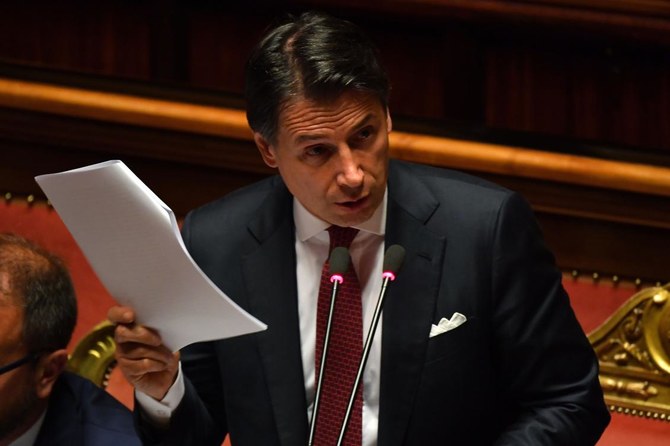
- The move leaves the eurozone’s third largest economy in a political vacuum until President Sergio Mattarella decides whether to form a new coalition or call an election
- The end of the 14-month-old coalition government opens the way for Mattarella to begin consultations with political parties, with a range of options available
Saudi Pavilion at Expo 2025 Osaka: A journey through Saudi Arabia’s transformation, Vision for Future
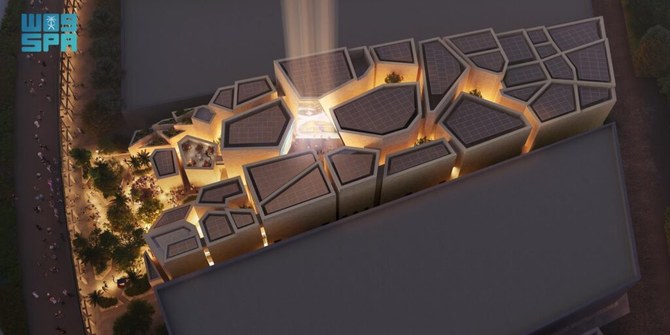
- Saudi chefs will present a mix of flavours inspired by different regions of the Kingdom
- More than 200 selections of souvenirs will be displayed in the gift shop, each a testament to authentic Saudi craftsmanship
OSAKA: The Saudi pavilion participating in Expo 2025 Osaka in Japan has announced an unprecedented cultural and artistic program encompassing more than 700 events to introduce visitors to Saudi Arabia’s rich heritage, mega projects and various economic opportunities.
The Saudi pavilion at the expo will present Saudi Arabia’s past, transformational journey and vision for a sustainable and prosperous future. It will include a wide range of performances, such as traditional arts, classical music and fashion shows.
Saudi chefs will present a mix of flavours inspired by different regions of the Kingdom, and Saudi musicians and artists will perform daily to highlight the Kingdom’s rich cultural heritage.
A dedicated area for prominent figures will host various sessions and display a series of presentations to inform companies and investors of all the economic opportunities available in the Kingdom.
More than 200 selections of souvenirs will be displayed in the gift shop, each a testament to authentic Saudi craftsmanship.
Visitors from around the world will learn about AlUla City, located in north-west Saudi Arabia, which is home to dramatic desert landscapes, spectacular rock formations and some of the Middle East’s most significant ancient sites.
Major Saudi projects will be highlighted, including NEOM, the land of the future; THE LINE, the 170-kilometer-long city that will be the future of urban living; Oxagon, which is redefining the traditional industrial model; and Trojena, the mountain resort of NEOM.
The pavilion will also showcase aspects of ‘Green Riyadh,’ a revolutionary project that aims to transform Saudi Arabia’s capital into a green oasis by planting 7.5 million trees by 2030. This project aims to place Riyadh as one of the world’s top 100 most livable cities.
It will also highlight the Reefscape Restoration Initiative, launched by the King Abdullah University of Science and Technology (KAUST). This initiative seeks to conserve, enhance, and restore 100 hectares of coral reefscape in the Red Sea and design and build the world’s largest Coral Nursery at Jeddah beach, with an expected coral production of 400k per year.
General Commissioner of the Saudi Pavilion Othman Al-Mazyad said: “We look forward to enabling visitors of the Saudi pavilion to learn about the Kingdom, its traditions, journey of transformation and vision for a sustainable future.”
Relations between Saudi Arabia and Japan have been continuously growing, thanks to the Saudi-Japanese Vision 2030. The Saudi Pavilion at Expo 2025 Osaka will allow companies and investors from Japan and worldwide to learn about the Kingdom’s various opportunities, aiming to forge new partnerships and expand existing agreements.
India’s mammoth election heats up in trend-defining second phase
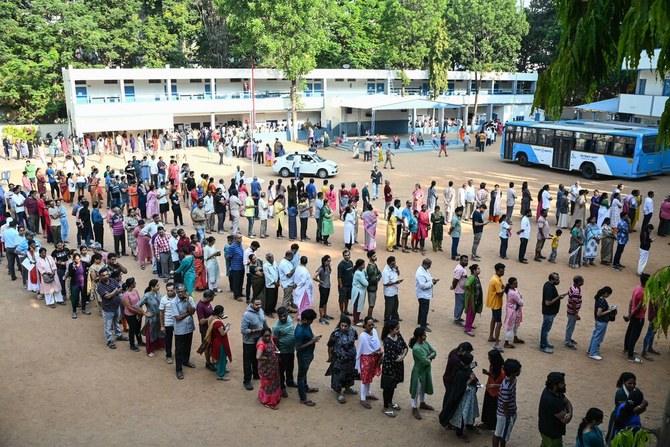
- Second phase is seen by analysts as defining dynamics of rest of the polls
- Turnout in first phase was lower than expected — 66 percent, compared with 70 percent in 2019
NEW DELHI: India’s mammoth general election rolled on Friday into its second phase, which is widely believed to likely set the trend for the rest of the polls.
More than 968 million voters were registered to cast the ballot vote in the world’s most populous country, where incumbent Prime Minister Narendra Modi and his Hindu nationalist Bharatiya Janata Party are eyeing a rare third straight five-year term in power.
The first phase of the vote was on April 19 as polling takes place over six weeks, with results expected on June 4. The other voting dates will be May 7, May 13, May 20, May 25 and June 1.
India has a total of 28 states and eight federally governed territories. Some regions complete the process on a single day, and others spread it out over several phases.
Voting last week took place in 21 states and union territories, with nearly 169 million people eligible to cast their ballots. In the second phase, more than 160 million people were expected to vote across 13 states and federal territories.
As many as 1,202 candidates contested the polls on Friday, vying for 88 of the 543 seats in the lower house of Parliament. In the previous phase, 102 seats were up for grabs.
More than half of the 88 seats were in the southern states of Kerala and Karnataka and the northwestern state of Rajasthan.
The party or coalition that wins at least 272 seats will form the government.
Modi, who ahead of the election was targeting 400 seats for his BJP-led National Democratic Alliance, is challenged by an alliance of two dozen opposition parties — the Indian National Developmental Inclusive Alliance, or INDIA, led by the Congress party, which has ruled the country for close to 45 years since independence in 1947.
‘MINI-GENERAL ELECTION’
The second phase of India’s polls is seen by analysts as defining the dynamics of the remaining five phases. One of the factors was the voter turnout, which in this election might be lower.
In the first phase, 66 percent of those eligible to vote cast their ballot — compared with 70 percent in 2019.
“From the first phase of the election, the message went that there is a silent undercurrent against the BJP and the dip in the voting percentage sent the signal that the BJP would slip in its strongholds in northern India particularly Uttar Pradesh,” Umakant Lakhera, political commentator in Delhi, told Arab News.
“If the trend of voters’ perceived apathy toward the election in general — and the BJP in particular — continues, then it’s an opportunity for the opposition Congress party to consolidate and mobilize its resources to widen its reach and capitalize on anti BJP sentiment.”
The key leader of the opposition coalition and Congress member is Rahul Gandhi, the son of Rajiv Gandhi, a grandson of Indira Gandhi, and a great-grandson of Jawaharlal Nehru, all of whom served as prime ministers of India.
Gandhi is seeking re-election from Wayanad in Kerala — the only major state that has never elected a BJP member of parliament, and where it was not a main competitor. This year, Modi’s party has been trying to make inroads into the state’s political scene.
The main contenders, besides Gandhi, are Annie Raja of the Communist Party of India and BJP’s K. Surendran.
“Kerala always has witnessed bipolar politics, but the BJP has been trying this time to make it a triangular contest, and this election will test whether a third force can find space in Kerala or not,” Prof. G. Gopa Kumar, political scientist and adviser to the Kerala-based Center for Public Policy Research, told Arab News.
“The second phase will test whether the stigma of the BJP of being an outsider in Kerala will continue or not, whether the stigma of not winning a seat in Kerala will continue or not.”
Far from Kerala, in the north, where several states were also going to the polls, another test was taking place at the same time — for the Congress party. Congress plunged to a historic low when it was swept out of power by the BJP in the 2014 general vote, and won its second-lowest number of 52 seats in 2019.
“The second phase is a mini-general election. What is at stake is whether the Congress is going to challenge the dominance of the BJP in the north Indian states like Uttar Pradesh, Rajasthan, Madhya Pradesh or not,” Kumar said.
“The contest is getting serious from now on. For the Congress, it is a survival question as they have to prove that they can defeat the BJP and survive as a big force.”
Although surveys suggest Modi will easily win a comfortable majority in parliament, his 400-seat target, often repeated ahead of the polls, has not been cited since last week’s first phase.
Asad Rizvi, an analyst based in Lucknow, the capital of India’s most populous state and BJP stronghold, Uttar Pradesh, said that the performance was apparently not as good as expected, despite the repetition of the party’s tactics of polarization along religious lines.
“A perception has come to dominate after the first phase of elections that the BJP has not performed well in its strongholds in Uttar Pradesh, therefore, the BJP will have a tough time mobilizing its core voters to retain the seats,” he told Arab News.
“The second phase is also crucial that will test whether the BJP’s communal agenda is working or not.”
Ukraine’s Zelensky calls for air defense systems as allies meet

- “We need the ability to shoot down the air combat aircraft so that they do not approach our positions and borders,” Zelensky said
- US Defense Secretary Lloyd Austin said the meeting would focus on Ukraine’s air defense capabilities
WASHINGTON: Ukrainian President Volodymyr Zelensky on Friday called for additional air defense systems to be sent to Kyiv to help protect against Russian strikes, adding that a pause in US funding had helped Moscow seize the initiative.
“This year, Russian jets (have) already used more than 9,000 guided aerial bombs against Ukraine and we need the ability to shoot down the air combat aircraft so that they do not approach our positions and borders,” Zelensky said at the start of a virtual meeting led by the United States on helping arm Ukraine.
US Defense Secretary Lloyd Austin said the meeting would focus on Ukraine’s air defense capabilities.
The meeting comes days after Congress emerged from a half-year of deadlock to approve a $61 billion aid package for Ukraine. President Joe Biden’s administration quickly announced $1 billion in artillery, air defenses and other hardware would soon be heading to Ukrainian front lines.
“While we were waiting for a decision on the American support, the Russian army managed to seize the initiative on the battlefield,” Zelensky said.
“We can still now, not only stabilize the front, but also move forward achieving our Ukrainian goals in the war,” he added.
The United States hopes its new deliveries of weaponry will help Ukraine rebuild defenses and refit its forces as it recovers from a gap in US assistance, but it does not expect Kyiv to launch large-scale offensive operations against Russian forces in the near term.
The influx of weapons could improve Kyiv’s chances of averting a major Russian breakthrough in the east, just over two years since the start of Moscow’s full-scale invasion, military analysts say.
But it remains unclear how much pressure Kyiv can apply on Russia after months of rationing artillery as its stocks ran low. Kyiv also faces manpower shortages on the battlefield and questions linger over the strength of its fortifications along a sprawling, 1,000-km (621-mile) front line.
India’s mammoth election heats up in trend-defining second phase
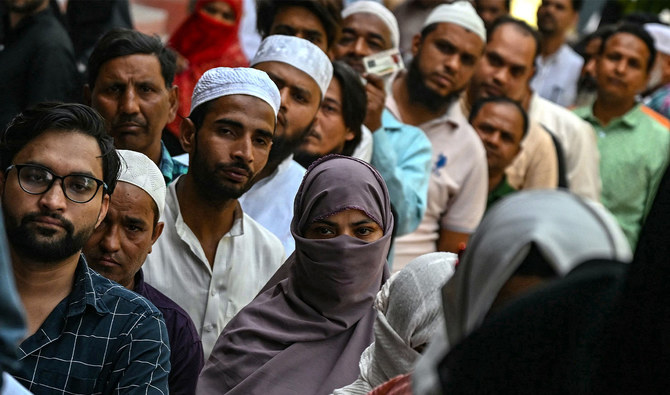
- Turnout in first phase lower than expected at 66 percent compared with 70 percent in 2019
- PM Modi and his BJP are eyeing a rare third straight five-year term in power
NEW DELHI: India’s mammoth general election rolled on Friday into its second phase, which analysts widely believe will likely set the trend for the rest of the polls.
More than 968 million voters are registered to cast the ballot vote in the world’s most populous country, where incumbent Prime Minister Narendra Modi and his Hindu nationalist Bharatiya Janata Party are eyeing a rare third straight five-year term in power.
Modi, who ahead of the election was targeting 400 seats for his BJP-led National Democratic Alliance led by his BJP, is challenged by an alliance of two dozen opposition parties: the Indian National Developmental Inclusive Alliance, or INDIA, led by the Congress Party, which has ruled the country for close to 45 years since independence in 1947.
The first phase of the vote took place on April 19. Polling will go on for six weeks, with results expected on June 4. The other voting dates will be May 7, May 13, May 20, May 25 and June 1.
Analysts say the second phase of India’s polls will define the dynamics of the remaining five phases.
In the first phase, 66 percent of those eligible to vote cast their ballot, compared with 70 percent in 2019.
“From the first phase of the election, the message went that there is a silent undercurrent against the BJP and the dip in the voting percentage sent the signal that the BJP would slip in its strongholds in northern India particularly Uttar Pradesh,” Umakant Lakhera, political commentator in Delhi, told Arab News.
“If the trend of voters’ perceived apathy toward the election in general, and the BJP in particular, continues, then it’s an opportunity for the opposition Congress party to consolidate and mobilize its resources to widen its reach and capitalize on anti BJP sentiment.”
India has a total of 28 states and eight federally governed territories. Some regions complete the voting process in a single day, and others have it spread out in several phases.
Voting last week took place in 21 states and union territories, with nearly 169 million people eligible to cast their ballots. In the second phase, more than 160 million people are expected to vote across 13 states and federal territories.
As many as 1,202 candidates contested the polls on Friday, vying for 88 of the 543 seats in the lower house of Parliament. In the previous phase, 102 seats were up for grabs.
More than half of the 88 seats were in the southern states of Kerala and Karnataka and the northwestern state of Rajasthan.
The party or coalition that wins at least 272 will form the government.
‘MINI GENERAL ELECTION’
The key leader of the opposition coalition and a Congress member is Rahul Gandhi, the son of Rajiv Gandhi, a grandson of Indira Gandhi, and a great-grandson of Jawaharlal Nehru, all of whom have served as prime ministers of India.
But the Congress plunged to a historic low when it was swept out of power by the BJP in the 2014 general vote, and won its second-lowest number of 52 seats in 2019.
Gandhi is seeking re-election from Wayanad in Kerala, the only major state that has never elected a BJP member of parliament, and where Modi’s party was not a main competitor but has been trying to make inroads since last year.
The main contenders, besides Gandhi, are Annie Raja of the Communist Party of India and BJP’s K. Surendran.
“Kerala always has witnessed bipolar politics, but the BJP has been trying this time to make it a triangular contest, and this election will test whether a third force can find space in Kerala or not,” Prof. G. Gopa Kumar, political scientist and adviser to the Kerala-based Center for Public Policy Research, told Arab News.
“The second phase will test whether the stigma of the BJP of being an outsider in Kerala will continue or not, whether the stigma of not winning a seat in Kerala will continue or not.”
Another test for the Congress will be far from Kerala, in the north, where several states were also going to the polls.
“The second phase is a mini-general election. What is at stake is whether the Congress is going to challenge the dominance of the BJP in the north Indian states like Uttar Pradesh, Rajasthan, Madhya Pradesh or not,” Kumar said.
“The contest is getting serious from now on. For the Congress, it is a survival question as they have to prove that they can defeat the BJP and survive as a big force.”
Although surveys suggest Modi will easily win a comfortable majority in parliament, his 400-seat target often repeated ahead of the polls has not been cited since last week’s first phase.
Asad Rizvi, an analyst based in Lucknow, the capital of India’s most populous state and BJP stronghold, Uttar Pradesh, said the party’s performance was not as good as expected despite its tactic to polarize along religious lines.
“A perception has come to dominate after the first phase of elections that the BJP has not performed well in its strongholds in Uttar Pradesh, therefore, the BJP will have a tough time mobilizing its core voters to retain the seats,” he told Arab News.
“The second phase is also crucial that will test whether the BJP’s communal agenda is working or not.”
Blinken says Gaza protests a hallmark of democracy, decries ‘silence’ on Hamas
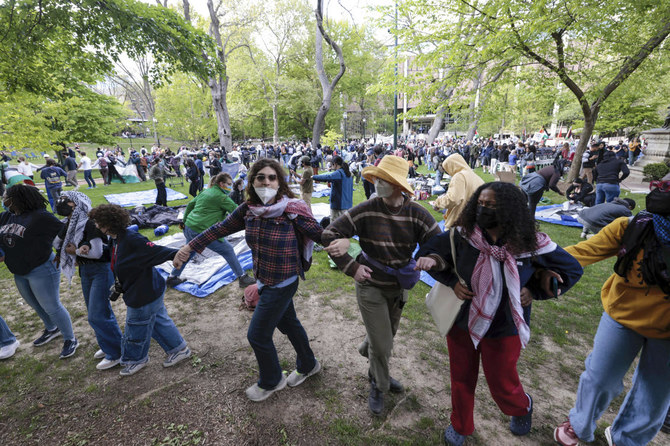
- Police have clashed with students critical of the war and the Biden administration’s support for Israel’s war in Gaza
- Blinken said he understood the conflict elicited “strong, passionate feelings” and that the administration was doing it all it could to halt the war
BEIJING: US Secretary of State Antony Blinken said on Friday protests at US universities over US-ally Israel’s war in Gaza are a hallmark of American democracy, but criticized what he called the “silence” about Palestinian militant group Hamas.
Police have clashed with students critical of the war and the Biden administration’s support for Israel’s war in Gaza, with nearly 550 arrests made over the protests in the last week across major US universities, according to a Reuters tally.
Asked at a press conference in China whether he was taking on board the protesters’ message, Blinken said he understood the conflict elicited “strong, passionate feelings” and that the administration was doing it all it could to halt the war.
“In our own country, it’s a hallmark of our democracy that our citizens make known their views, their concerns, their anger, at any given time, and I think that reflects the strength of the country, the strength of democracy,” Blinken said.
But he suggested critics should focus their ire on Hamas militants who sparked the war with their Oct. 7 attack on southern Israel in which about 1,200 people were killed and some 250 taken hostage, according to Israeli tallies.
Israel’s military response has killed more than 34,000 Palestinians and injured more than 77,000, according to the health ministry in Hamas-ruled Gaza.
“It is also notable that there is silence about Hamas, as if it wasn’t even part of the story,” Blinken said.
“But as I’ve also said repeatedly, the way Israel goes about ensuring that Oct. 7 never happens again matters profoundly. And we’re working every day to try to minimize the damage that’s done to innocent people and to make sure that they have the assistance and support that they need.”
Blinken, who met Chinese President Xi Jinping and other officials in Beijing on Friday, said he had discussed how China can play a constructive role in global crises, including in the Middle East, where he said Beijing can discourage Iran and its proxies not to escalate the conflict.
Blinken said he spoke to Foreign Minister Wang Yi multiple times this month when tensions spiked between Israel and Tehran. China is the main buyer of oil exported by sanctions-hit Iran.
“I think the relationships, again, that China has can be positive in trying to calm tensions, prevent escalation, avoid the spread of the conflict, and we agreed that we’d remain in regular in regular touch on this, and that’s certainly my intention,” Blinken said.




